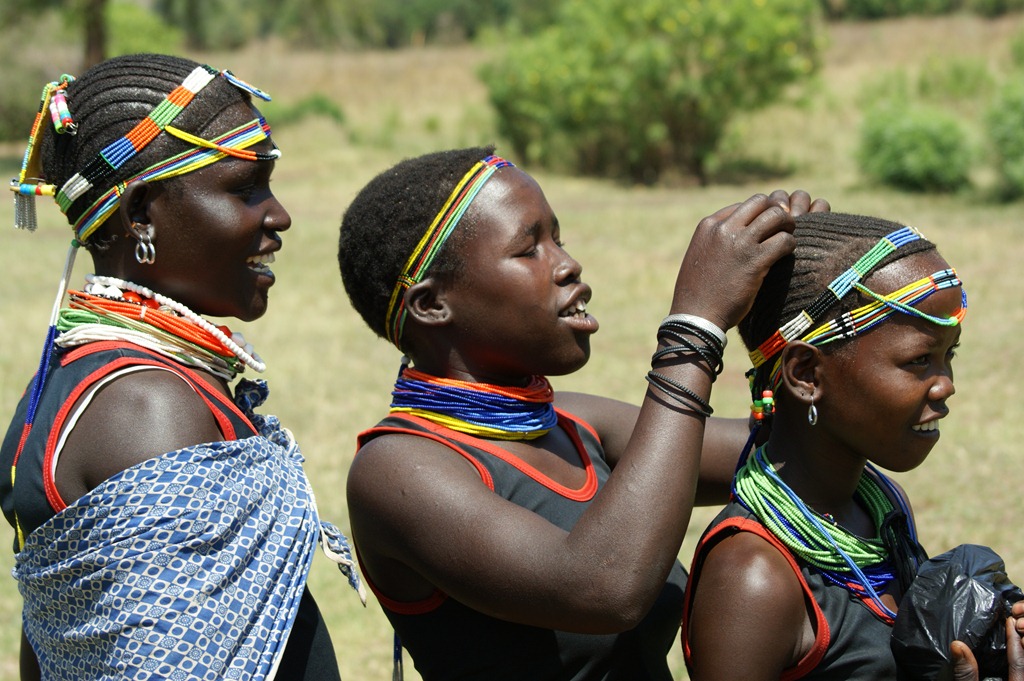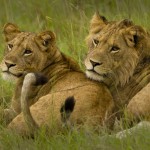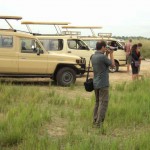
These people are often referred to as the Plain Nilotes. In Uganda, they constitute the Atekerin or the Lango group which includes the Karimojong, the Iteso, the Langi, the Kumam and the Kakwa. Their origins can be traced to the north east, probably the Kaffa region of Ethiopia. During their migrations, the whole group is said to have first settled in Karamoja. From there they moved south to occupy Teso, Lango and Kumam. Some of them like the Langi lost their original language and some cultural traits due to influence. However, some of their peculiarities in custom and culture can still be identified.
THE LANGI
The Langi belong to the Lango family which also comprised the Iteso and the Kumam, the Labwor, the JIe (Lango- Okolok) and the Karamajongo (Lango-Dyang).
Origins
Tradition asserts that the Langi originated form Mt. Otukei, also called Mt.Awil. They claim that they came from mountains which had abundant rain. This Land could be Kaffa and this presupposed indeed that the Langi originated form Abyssinia. Their original homeland was north of Lake Turkana where they used to live along with the JIe and the Karimojong. This means, by implication, that the Langi are also related to Dodoth, Lotuko, Topsa, and Turkana of Kenya. Together with the Iteso, Kumam and Karimojong, they comprise the Atekerin family in Uganda.
Religion
The Langi believe din a spiritual being called Jok. Jok was a super being and a wider concept manifested into Jok- Lango who specialized in diseases which had little or nothing to do with demon-possession. All demon possession fell under the sphere of Jok-Man. Other manifestations of Jok included Jok-Atida and Jok – Orongo. Though spiritual, Jok was taken as an individual entity, not a particular manifestation. He could sometimes be taken to mean the devil with powers to make people contract diseases or meet undesirable fates. In their human form these joggi (plural) were believed t be in several respects like human beings for they were mortal, male or female, and their society was believed to uphold marriage and decry adultery. They were said to celebrate birth and weep for the dead.
In their human form, they were said to have long curly, tangled hair, a black or slightly brown skin, sometimes tarnished by dust. However, they would be different form human beings in that what was fair to them was foul to human beings and vice versa. For instance, their most delicious food was said to be house flies.
The Langi were not much concerned with the world after death. What was clear to them was that when a person died, his spirit did not die but went to the world of the dead. Nothing was known about this world except that the souls of the people who had died with grief or died in bitter resentment against their relatives, could ally with evil Joggi and acquire the power to haunt those against whom they had grudges.
Every Langi family had an ancestral shrine be offered t propitiate the relevant Joggi. This was import because the evil spirits could possess any one of their relatives. In the event of such a happening a sheep was killed to placate the spirit and a ceremony was performed to drive the evil spirit out of the victim. An evil spirit which stubbornly refused to move out of the victim whenever the appropriate ceremony had been performed was called cen. The witch doctor (ajwaka) could, however, always get the better of it and in such a case he would trap it and deal it in a pot or a calabash. There was no mercy for any evil sprit which has stubbornly refused to leave the victim peacefully. Once trapped, unless it repented of its past malice and promised t reform, the object in which it had been trapped was buried in a swamp and that would mark the end of the spirit. Some times, such obstinate spirits, it is said, could even be speared to death.
When it was time for sowing, the Langi would invoke the power and blessing of Jok by a ceremony called Rubo koti (the mixture of seeds). This ceremony was often accomplished by sacrifice of a sheep or a chicken, the throat of which would be cut and the blood allowed to drip into the seeds. It was believed that in the absence if this blood, the seeds would not germinate.
Dwelling
The Langi dwelt in villages. A village could contain more than a hundred huts built in a line. In front of the hut, there was a line of granaries belonging to the individual families. Beyond them, at a distance, was the community cattle kraal.
When some one needed a new site on which to build a hut, he would take a chicken and some beer to the desired site and leave them there for a day or two. If on his return he found that something had eaten the chicken or drunk the beer, he would abandon the site as it was considered an ill-omen. For fear of evil spirits, the Langi avoided building near swamps and also avoided building near stony or rocky ground.
The huts were of different types. An iguruguru was a small hut intended for sleeping in as a guest house. It was, made with a low doorway that people had to enter crawling. The prose of the low doorway was to prevent enemies from aiming their spears at the people sleeping during the night. The unmarried youths slept in small huts called otogo whose doorways, approached by means of a ladder, were only big enough to allow a person to craw in and out. This type of hut is now very rare but it had its entrance closed by a grass mat and is said to have been very warm inside.
Implements
Formerly, the implements of the Langi were few and simple. As a bed, they used a hide which was usually stretched on a raised floor in the hut. The women’s utensils included various pots, a pan, calabashes, drinking vessels, brooms, pestles, and mortars, plus a number of grinding stones. The man had his spear, a knife, a hunting net, a drum and a hoe. Among his favorite implements was a drinking stick which looked much like an ordinary stick but was in fact hollow with a sucking tube inside.
Dress
The Langi were not used to wearing clothes but they were fond of personal adornments. When they still lived in Karamoja, the men went completely naked. The women used to wear ajoo (a skin). When the Langi came in contact with the Acholi during the Luo migrations, they adopted the Acholi ways of dressing and also dropped their Ateker language and spoke Lwo. The men of the Jo- Aber clan were the first to wear goat-skins and were pioneers in rejecting their traditional ajoo in favor of apronon. It is in the recent past that the other men of the west and the south started to wear skins; until then, they used to go stark naked.
Personal Adornments.
The Langi girls were tattooed both on the back and front. Men were only tattooed on the back. The Two lower teeth were removed and the ears were pierced in as many as ten points to provide accommodation for gilo beads. Metallic ornaments wee worn in the nose and the upper lip. Often the lower lip was also pierced to accommodate such objects as took the owner’s fancy. Piercing was sometimes extended to the tongue to enable it to accommodate a two-beaded ornament.
On their arms and legs, they wore a large quantity of bracelets both above and below the knees and elbow and around their ankles and wrists. Their necks were also encased in another pile of bracelets rendering them almost stiff. Their women often rubbed roasted simsim on their heads and twisted their hair. Both men and women were found of smearing their bodies with oil and ghee. Often, the men would work their hair into elaborate headdresses as the Jie and the Karimajong have been doing recently and some still do. They would plaster themselves with mud and stud them with beads. Women were also fond of wearing a big brass rind on the wrist and during quarrels; they frequently hit each other on the head with these big brass rings.
Political set-up
Lango society was segementary; leadership was centered around the clan which would be both a kinship unit and the basic constituency of politics within the Rwotdoms. The Rwot (chief) had the duty of controlling the entire clan. He was helped by council of elders. The other senior members besides the Rwot were the leading elders of the clan. The council of elders was responsible for the general administration and the maintenance of law and order within the clans. They organized the payment of debts,Luk (adultery and fornication fines) as well as bridewealth. This council was also responsible for the distribution or deposition of the property of the deceased.
Many clan elders were usually brought together to form the Odonge- Atekere and one of them would be elected Rwot or Awitong as he was called. The Odongo-Atekere were the clan branch leaders and the Rwot had the duty of controlling alls the affairs of the clan. He led the warriors to war and mobilized defense during an invasion. After battle, he organized a feast during which the Moo and Moi (military ranks) wert coffered upon those that deserved them. These ranks were for those who had displayed excellent performances during the battle.
Military.
The society had no standing army. All able-bodied men were considered warriors. Before war could be declared, a foreteller would be consulted t predict the results of the war. If luck was prove, old women would spit into the hands of the warriors and they would then set off. The leaves of the olwedo tree were put in the path where the warriors passed t enhance their luck in the impending fight.
War booty was normally retained by whoever looted it. After the war, a ceremony was convened in which to award the Moi ranks. The person who killed a big or important person was styled Anuk; his privileges and other titles were increased by making tattoo marks on his left shoulder and neck. The highest Moi was Abwangor. During this ceremony, a goat was slaughtered while the elders stood in front of the family shrine and its blood was allowed to drip on the warriors. The goat was then skinned and its meat divided accordingly.
Judicial system
The judicial system of the Langi was harsh by modern standards because in certain instances, offenders could be dealt with on the spot by whoever caught them. For instance, there was no case to answer if a man speared another one to death after having found him sleeping with his wife. There was nothing like man slaughter since a murderer would be killed if he was caught. So also could a notorious thief. As for the latter, he could even be killed by his own people.
Often on the intervention of elders, murder could be compensated in the form of goats, cows or a young girl. If the murdered person was a man and the girl who would be surrendered gave birth to a boy, she would be set free and returned t her people. If she had proved good, she would be married to a young man within the clan and bridewealth would be accordingly paid. Murder victims were almost always men since it was considered cowardly to kill a woman or a child.
If a woman killed her husband, she would be returned to her people and the bride wealth would be refunded. She would in addition be required to pay compensation. The woman had a lesser role than a man to play in society except as sources of wealth and custodians of the rituals of birth divination.
Other offences in the Lango society included pre-marital pregnancies and fornication. If a boy refused to marry a girl and the girl died in labour, the case was tantamount to murder. If she successfully delivered, the child would remain property of the girl’s parents and could only be redeemed if the boy married the girl.
Wizards were usually held responsible for causing deaths, the failure of crops, long periods of drought and other devilish acts against society. Such wizards whenever caught or proven were executed. Proof in such cases was always arbitrary. Part of such proof was the possession of odd objects whose purpose was completely unknown to the people, for example, the placenta of a new born baby or the bones of a dead person.
The Family Shrine (Abila)
It was built in front of the home and it was identified by particular plants. The shrine had a great degree of sacredness surrounding it. It was not only a resting place for the ancestral spirits but it was a place where spears were blessed before and after the hunt. All skulls of the animals which were killed during the hunt were placed at the Abila and, except for the very elderly; women were forbidden from changing anything placed in the Abila.
Economy
The Langi were originally pastoralists and they ate meat and milk mixed with blood. Their economy was non-monetary and they used to barter goats, grains and cattle with the Acholi, the Labwor, and the Kumam and later, with the Arabs. As they continued to be pushed towards the shores of Lake Kioga, they discarded their pastoral economy.
Their first food crops were millet, (okama), and atunuru ngor (pigeon peas), amola (hyptis species), adura (eratocheca sesamoides), okwer (a species of cucumber), alao (crotalaria species) and otigo (corchorous species).
Later, the langi started to grow ground nuts and sweet potatoes which were introduced form Bunyoro during the reign of Kabalega. They also grow and eat simsim which was introduced by the colonial government in 1911. They used to eat the meat of almost all wild birds and animals except the jackal and the hyena. Another thing they could not eat was byero (afterbirth cows, sheep or goats).

 Posted in
Posted in 

